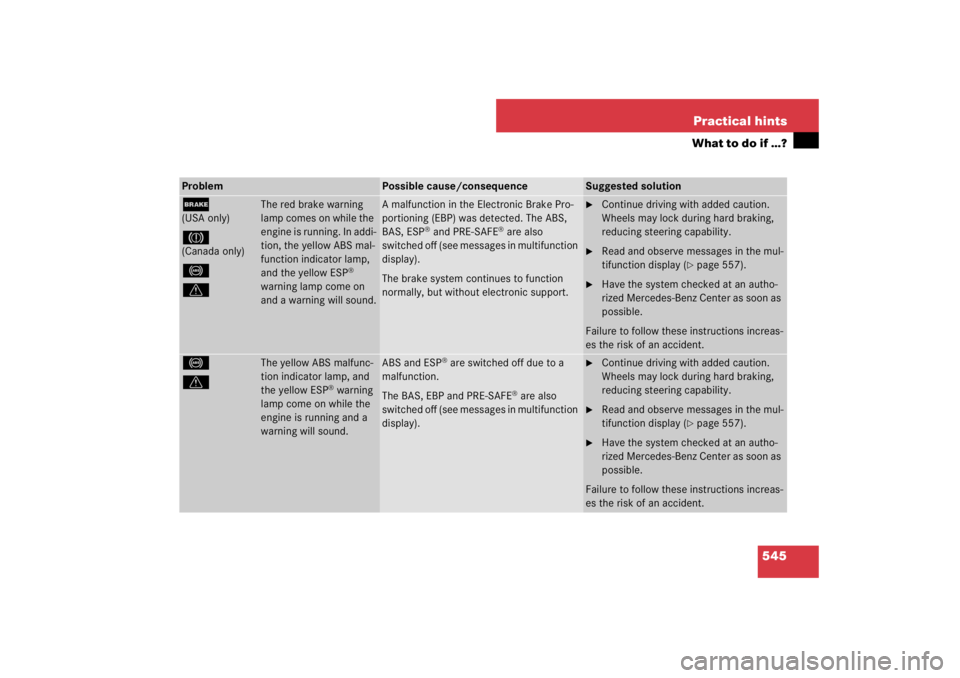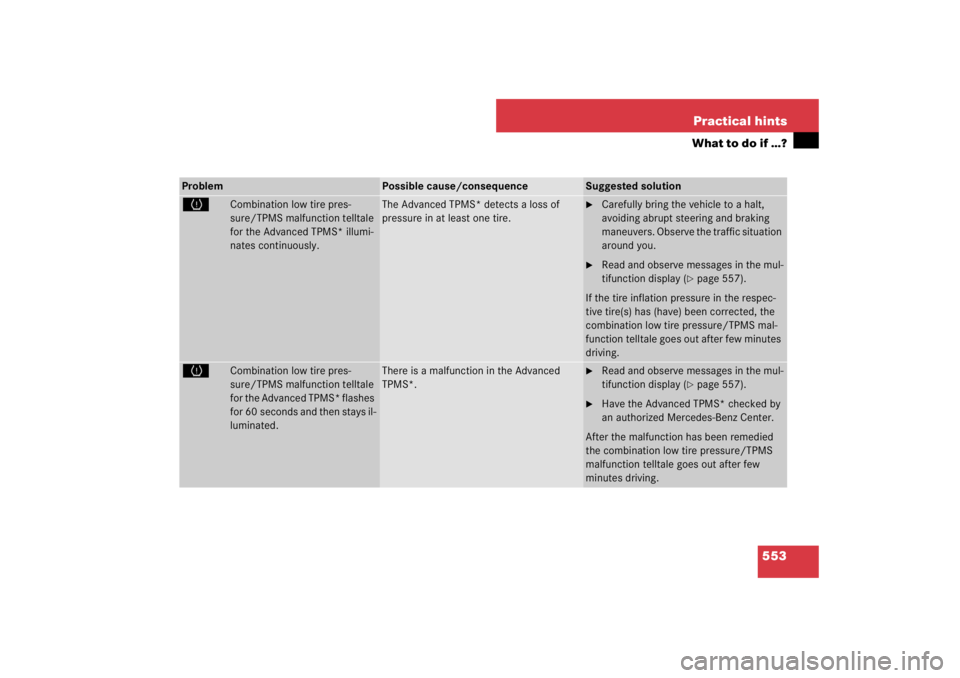Page 546 of 705

545 Practical hints
What to do if …?
Problem
Possible cause/consequence
Suggested solution
;(USA only)3(Canada only)-
v
The red brake warning
lamp comes on while the
engine is running. In addi-
tion, the yellow ABS mal-
function indicator lamp,
and the yellow ESP
®
warning lamp come on
and a warning will sound.
A malfunction in the Electronic Brake Pro-
portioning (EBP) was detected. The ABS,
BAS, ESP
® and PRE-SAFE
® are also
switched off (see messages in multifunction
display).
The brake system continues to function
normally, but without electronic support.
�
Continue driving with added caution.
Wheels may lock during hard braking,
reducing steering capability.
�
Read and observe messages in the mul-
tifunction display (
�page 557).
�
Have the system checked at an autho-
rized Mercedes-Benz Center as soon as
possible.
Failure to follow these instructions increas-
es the risk of an accident.
-
v
The yellow ABS malfunc-
tion indicator lamp, and
the yellow ESP
® warning
lamp come on while the
engine is running and a
warning will sound.
ABS and ESP
® are switched off due to a
malfunction.
The BAS, EBP and PRE-SAFE
® are also
switched off (see messages in multifunction
display).
�
Continue driving with added caution.
Wheels may lock during hard braking,
reducing steering capability.
�
Read and observe messages in the mul-
tifunction display (
�page 557).
�
Have the system checked at an autho-
rized Mercedes-Benz Center as soon as
possible.
Failure to follow these instructions increas-
es the risk of an accident.
Page 554 of 705

553 Practical hints
What to do if …?
Problem
Possible cause/consequence
Suggested solution
H
Combination low tire pres-
sure/TPMS malfunction telltale
for the Advanced TPMS* illumi-
nates continuously.
The Advanced TPMS* detects a loss of
pressure in at least one tire.
�
Carefully bring the vehicle to a halt,
avoiding abrupt steering and braking
maneuvers. Observe the traffic situation
around you.
�
Read and observe messages in the mul-
tifunction display (
�page 557).
If the tire inflation pressure in the respec-
tive tire(s) has (have) been corrected, the
combination low tire pressure/TPMS mal-
function telltale goes out after few minutes
driving.
H
Combination low tire pres-
sure/TPMS malfunction telltale
for the Advanced TPMS* flashes
for 60 seconds and then stays il-
luminated.
There is a malfunction in the Advanced
TPMS*.
�
Read and observe messages in the mul-
tifunction display (
�page 557).
�
Have the Advanced TPMS* checked by
an authorized Mercedes-Benz Center.
After the malfunction has been remedied
the combination low tire pressure/TPMS
malfunction telltale goes out after few
minutes driving.
Page 558 of 705

557 Practical hints
What to do if …?
Vehicle status messages in the multi-function display
Warning and malfunction messages ap-
pear in the multifunction display located in
the instrument cluster.
Certain warning and malfunction messag-
es are accompanied by an audible signal.
High-priority messages are shown in red
on the multifunction display. Messages of
lower priority are also shown in yellow or
white.
Address these messages accordingly and
follow the additional instructions given in
this Operator’s Manual.Certain messages of high priority cannot
be cleared from the multifunction display
using# or L on the multifunction
steering wheel (
�page 242).
Other messages of high priority and mes-
sages of less immediate priority can be
cleared from the multifunction display
using# or L. They are then stored
in the vehicle status message memory
(
�page 253). Remember that clearing a
message will only make the message dis-
appear. Clearing a message will not cor-
rect the condition that caused the
message to appear.
Warning!
G
No messages will be displayed if either the
instrument cluster or the multifunction dis-
play is inoperative.
As a result, you will not be able to see infor-
mation about your driving conditions, such
as speed or outside temperature, warn-
ing/indicator lamps, malfunction/warning
messages or the failure of any systems.
Driving characteristics may be impaired.
If you must continue to drive, please do so
with added caution. Visit an authorized
Mercedes-Benz Center as soon as possible.
Page 569 of 705

568 Practical hintsWhat to do if …?Display
Possible cause/consequence
Possible solution
Tire pressure
Check tires
The pressure has fallen significantly in one
or more tires.
�
Carefully bring the vehicle to a halt, avoiding abrupt steering
and braking maneuvers. Observe the traffic situation around
you.
�
Check and adjust tire inflation pressure as required
(�page 511).
�
If necessary, change the wheel (
�page 629).
�
Restart the Run Flat Indicator* after adjusting the tire infla-
tion pressure values (
�page 516).
Tire pressure monitor
inoperative
The Advanced TPMS* or a wheel sensor is
malfunctioning.
�
Have the Advanced TPMS* checked by an authorized
Mercedes-Benz Center.
Tire pressure monitor
inoperative
No wheel sensors
The Advanced TPMS* is deactivated be-
cause wheels without proper sensors were
installed.
�
Have the wheel sensors installed by an authorized
Mercedes-Benz Center.
As soon as all wheels with sensors have been mounted, the
Advanced TPMS* is switched back on after driving for sever-
al minutes.
Warning!
G
Do not drive with a flat tire. A flat tire affects
the ability to steer or brake the vehicle. You
may lose control of the vehicle. Continued
driving with a flat tire will cause excessive
heat build-up and possibly a fire.
Page 571 of 705
570 Practical hintsWhat to do if …?Symbol messagesDisplay
Possible cause/consequence
Possible solution
Malfunction
Stop Vehicle!
You have started driving although the vehi-
cle level is still too low.
The vehicle is raised. The ABC* message
goes out after a few seconds.
�
Stop your vehicle as soon as it is safe to do
so.
�
Wait until the message disappears from the
multifunction display.
You may then drive off.
The vehicle is losing oil.
The ABC* message is continuously shown.
�
Stop your vehicle as soon as it is safe to do
so.
�
Call Roadside Assistance.
�
Notify an authorized Mercedes-Benz Center.
ABC* is malfunctioning.
The ABC* message is continuously shown.
�
Do not turn steering wheel too far to avoid
damaging the front fenders.
�
Listen for scraping noises.
�
Do not exceed a speed of 50 mph (80 km/h).
�
Visit an authorized Mercedes-Benz Center as
soon as possible.
Page 586 of 705

585 Practical hints
What to do if …?
Display
Possible cause/consequence
Possible solution
STOP,
car too low
You have started driving although the vehi-
cle level was too low.
The vehicle will be raised. The Airmatic*
warning lamp goes out after several sec-
onds.
�
Stop your vehicle as soon as it is safe to do
so.
�
Wait until the message disappears from the
multifunction display.
You may then drive off.
STOP,
car too low
The Airmatic* is malfunctioning.
The Airmatic* warning lamp lights up con-
tinuously.
�
Stop and press the vehicle level control but-
ton to select a higher vehicle level
(�page 401).
�
Do not turn steering wheel too far to avoid
damaging the front fenders.
�
Listen for scraping noises.
�
Do not exceed a speed of 50 mph (80 km/h).
�
Visit an authorized Mercedes-Benz Center as
soon as possible.
There is otherwise danger of an accident.
Malfunction
The capability of the Airmatic* system is re-
stricted. This can impair the handling.
�
Do not exceed a speed of 50 mph (80 km/h).
�
Visit an authorized Mercedes-Benz Center as
soon as possible.
Page 608 of 705

607 Practical hints
What to do if …?
Display
Possible cause/consequence
Possible solution
Tele Aid
inoperative
One or more main functions of the Tele Aid
system are malfunctioning.
�
Have the Tele Aid system checked by an au-
thorized Mercedes-Benz Center.
Tire pressure
Caution, tire defect
Vehicles with Advanced TPMS*:
One or more tires are deflating.
�
Carefully bring the vehicle to a halt, avoiding
abrupt steering and braking maneuvers.
�
If necessary, change the wheel (
�page 629).
Caution
Tire defect
Vehicles with Advanced TPMS*:
One or more tires are deflating. The respec-
tive tire is shown in the multifunction dis-
play.
�
Carefully bring the vehicle to a halt, avoiding
abrupt steering and braking maneuvers.
�
If necessary, change the wheel (
�page 629).
Warning!
G
Do not drive with a flat tire. A flat tire affects
the ability to steer or brake the vehicle. You
may lose control of the vehicle. Continued
driving with a flat tire will cause excessive
heat build-up and possibly a fire.
Page 609 of 705
608 Practical hintsWhat to do if …?Display
Possible cause/consequence
Possible solution
Tire pressure
Check tires
Vehicles with Advanced TPMS*:
The pressure is too low in one or more tires.
�
Carefully bring the vehicle to a halt, avoiding
abrupt steering and braking maneuvers.
�
Check and adjust tire inflation pressure as
required (
�page 514).
�
If necessary, change the wheel (
�page 514).
Check tires
Vehicles with Advanced TPMS*:
The pressure is too low in one or more tires.
The respective tire is shown in the multi-
function display.
�
Carefully bring the vehicle to a halt, avoiding
abrupt steering and braking maneuvers.
�
Check and adjust tire inflation pressure as
required (
�page 514).
�
If necessary, change the wheel (
�page 514).
Warning!
G
Do not drive with a flat tire. A flat tire affects
the ability to steer or brake the vehicle. You
may lose control of the vehicle. Continued
driving with a flat tire will cause excessive
heat build-up and possibly a fire.